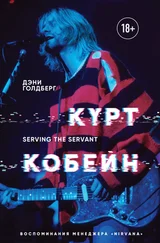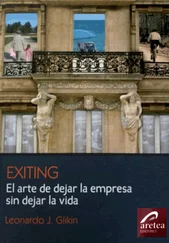Clara Park - Exiting Nirvana
Здесь есть возможность читать онлайн «Clara Park - Exiting Nirvana» весь текст электронной книги совершенно бесплатно (целиком полную версию без сокращений). В некоторых случаях можно слушать аудио, скачать через торрент в формате fb2 и присутствует краткое содержание. ISBN: , Жанр: Психология, на английском языке. Описание произведения, (предисловие) а так же отзывы посетителей доступны на портале библиотеки ЛибКат.
- Название:Exiting Nirvana
- Автор:
- Жанр:
- Год:неизвестен
- ISBN:0-316-69117-8
- Рейтинг книги:4 / 5. Голосов: 1
-
Избранное:Добавить в избранное
- Отзывы:
-
Ваша оценка:
- 80
- 1
- 2
- 3
- 4
- 5
Exiting Nirvana: краткое содержание, описание и аннотация
Предлагаем к чтению аннотацию, описание, краткое содержание или предисловие (зависит от того, что написал сам автор книги «Exiting Nirvana»). Если вы не нашли необходимую информацию о книге — напишите в комментариях, мы постараемся отыскать её.
All illustrations are by Jessy Park.
Exiting Nirvana — читать онлайн бесплатно полную книгу (весь текст) целиком
Ниже представлен текст книги, разбитый по страницам. Система сохранения места последней прочитанной страницы, позволяет с удобством читать онлайн бесплатно книгу «Exiting Nirvana», без необходимости каждый раз заново искать на чём Вы остановились. Поставьте закладку, и сможете в любой момент перейти на страницу, на которой закончили чтение.
Интервал:
Закладка:
It’s a happy task. The holiday itself is happy to think about, and her chosen subject matter makes it happier still. Twenty years of little cards adorn our kitchen, the multicolored record of Jessy’s «enthusiasms», her obsessions, unalloyed by the lurking anxieties that lie in ambush for them in real life.
Each 3-by-5 card is a miniature painting. There are double- yolked eggs. There’s a whole series of astrothings — solar eclipses, lunar eclipses, the planets in full array. There’s Venus rising, so bright that it casts a shadow. There’s a horizon with a green flash. There are five bees, safely dead. A monarch butterfly is so exquisitely detailed it seems real. A tomato hornworm recalls Jessy’s first pun, and her happy laugh when the hornworm blew its horn.
Time passes; enthusiasms «wear away» and new ones succeed them. No more astrothings, but houses, all sorts of houses. That was the period — it lasted more than a year — when Jessy, her voice tense with pleasure, would tell you, «I’m interested in real estate/» And she was, but not the way other people are interested in real estate; the economics of it meant nothing to her. Rather, her interest was in classification for its own sake. The phrase «starter house» made her shiver with delight. She would go on and on about «luxury homes», «million-dollar homes», though that was a category, not a price, determined not by grandeur of grounds or architecture, but (of course) the number of bedrooms, baths, and half-baths. And now, banks…
But other cards are less autistic, more sociable, as Jessy learns to look for subjects that are appropriate to their recipients. There are cat portraits for her cat-loving sister. Her Scottish brother-in- law, born in Glasgow on St. Patrick’s Day, gets a four-leaf clover for his birthday, for Christmas (my suggestion) the Glasgow city seal. The real estate enthusiasm itself grew out of actual conversations with her friend Anna about the purchase of a starter house. Like her books, her little cards show a progression, unsteady but real, toward engagement with the ordinary world.
What’s art is a matter of definition. «Those are the cookie art», Jessy said of her SING-SANG-SUNG collage. She never applied that term to her books. The Book About the Shadow, about the troubling Light, were in another category, one she could recognize though she couldn’t name it. They were functional records; that was why, I think, she seldom bothered with color, why she took no trouble with her drawing, except when an obsessive anxiety called forth the eerie realism of the science building or the shadow cast by an enormous 78. Color was for beauty, I think, though Jessy wouldn’t have said that either. So she cut out school menus and painted them and pasted them up in pastel strips; she made collages with multicolored silly business and crumpled tissue paper and her own name in string. The books were important, but I don’t think the farthest-out critic would call them art, still less apply the term to the illustrations for the journals she’s kept intermittently since the books were abandoned. As drawings, there is nothing remarkable about them except that they were the drawings of an autistic child and are now the drawings of an autistic adult. Jessy was four when she drew her first crude representation of a human being. She was nine when the comic books began. And since that time her representations of human figures have not changed at all.
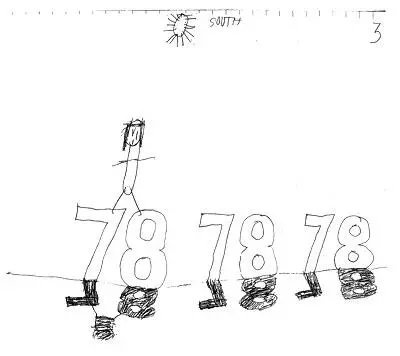
Shadows cast by the number 78, and by the stick figure of Jessy herself.
It is remarkable when an adolescent, still more an adult, still more an adult who has been taught to draw, draws like a child. Paul Klee did not, for all his attraction to children’s art; more precisely, he could not. Nothing is more difficult than to draw like a child unless you are one. I would say impossible, except that Jessy does it. I watch her as for the ten-thousandth time she makes a circle for the head, an oval for the unclothed body, single short strokes for each arm and leg. Only the hair differentiates individuals; hers is straight, mine curls, boys and men have none. The whole figure is done in less time than she’d take to write it. In fact she is writing it. It’s clear what these are: not drawings but ideograms, conventional, rapid, unvarying. They have nothing in common with her renditions of buildings or her portraits.
Those portraits are surprisingly skillful, considering that there are so few of them — no more than can be counted on the fingers of one hand. She made them in 1973. Ask her today if she’d draw a person and she’ll say no: «too hard». But then it was different. The portraits were set assignments. Anna and Diana were teaching her to draw.
The twins met Jessy in art class. As she entered high school, art (like gourmet cooking and, later, business math) was something she could take with normal children. It didn’t take long for the teachers to discover that this bizarre youngster who screamed at the bells and scratched in the wrong places and could hardly talk could do any assignment given the normal teenagers. She could do a still life with a flag and a bottle, she could render the same subject cubistically… if she understood that that was what she was supposed to do. So it was that Anna and Diana entered her life. Fascinated by the paradox of someone nearly their own age who acted like a four-year-old when she wasn’t acting worse, yet could draw anything set in front of her, they appointed themselves interpreters between her and the busy teachers. They were among the few who could draw better than she could, and they decided to really teach her to draw. They didn’t go for cubism or weird subject matter. Theirs was the tried and true method of the Renaissance workshops, and it was exactly right for a person with autism; they made model drawings and had her copy them. There was nothing «creative» about their assignments, nothing expressive. Once or twice people had tried to get Jessy to draw a «happy» or «sad» picture; she had no idea what they wanted of her. The twins were concrete, definite; they told her firmly what to do and she did it. They set her subjects she never would have chosen — flowers, interiors, even those portraits. She developed a line of exquisite sureness; a drawing of Anna seated (reproduced in The Siege) looks almost like a Matisse. Only the date makes it credible that it comes from the same year as the last of her books. A portrait of her father is an instantly recognizable likeness, of him as well as of the wicker chair he sits in — while in the foreground looms a large bare foot. It’s Jessy’s own, there in the drawing as it was in her line of vision as she sat opposite him on the bed. What child of five has not absorbed the social knowledge that you don’t include your foot in a picture of your father? But Jessy drew what she saw. It is the mind, not the eye, that selects.
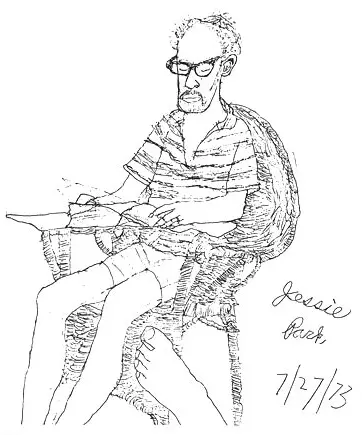
Jessy’s portrait of her father, done in her teens, about the same time as the 78 drawing.
The twins taught her academic drawing, and year after year, for the nine years she remained in high school, the teachers taught her too. When Anna and Diana went off to college, Jessy, unless in school, rarely took up a pencil.
Or a brush. For before the twins got to work, Jessy had had another teacher. Valerie was a painter. Jessy had painted in nursery school — repetitive triangles, squares, zigzags — abstract patterns, oddly neat for a small child, balanced, controlled, composed. She had paints at home — she understood that red and white make pink before I told her — but unless I set them up she preferred the ease of crayons, using them to draw, not to color. But Valerie had acrylics, and acrylics are quick-drying, as easy to use as the poster paints of nursery school. With Val’s encouragement, Jessy’s colors — and her obsessions — bloomed into glory. That summer’s recurrent theme was Dutch elm disease, three trees healthy and one afflicted, a background of greens and blues and rich reds, or stars and rainbows, or the variously rayed sun. But Valerie lived with us only one summer. It would be years before Jessy would — except on assignment — paint again.
Читать дальшеИнтервал:
Закладка:
Похожие книги на «Exiting Nirvana»
Представляем Вашему вниманию похожие книги на «Exiting Nirvana» списком для выбора. Мы отобрали схожую по названию и смыслу литературу в надежде предоставить читателям больше вариантов отыскать новые, интересные, ещё непрочитанные произведения.
Обсуждение, отзывы о книге «Exiting Nirvana» и просто собственные мнения читателей. Оставьте ваши комментарии, напишите, что Вы думаете о произведении, его смысле или главных героях. Укажите что конкретно понравилось, а что нет, и почему Вы так считаете.
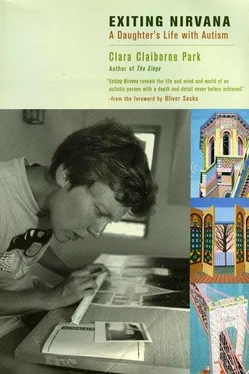
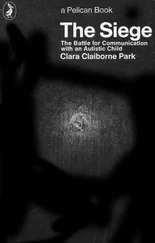
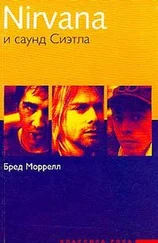
![Майкл Азеррад - Come as you are - история Nirvana, рассказанная Куртом Кобейном и записанная Майклом Азеррадом [litres]](/books/392533/majkl-azerrad-come-as-you-are-istoriya-nirvana-ra-thumb.webp)
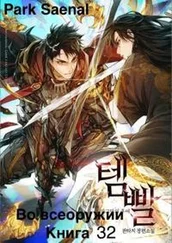
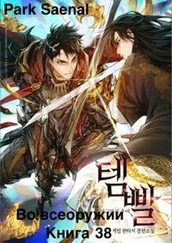

![Эверетт Тру - Nirvana - Правдивая история [litres]](/books/399241/everett-tru-nirvana-pravdivaya-istoriya-litres-thumb.webp)
